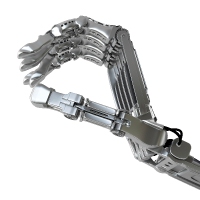 A new generation of bionics which can connect wirelessly with the nervous system and feel are under development. The next generation of bionics will try to overcome problems and offer some sensory feedback to the user.
A new generation of bionics which can connect wirelessly with the nervous system and feel are under development. The next generation of bionics will try to overcome problems and offer some sensory feedback to the user.
The current generation of bionic hands can pinch or grasp using two or more electrodes fitted inside the portion of the prosthetic which fits over the stump. These electrodes are positioned to pick up signals from the user’s peripheral nerve system that are naturally amplified by muscles in the stump.
Progress is almost continuous. German company Otto Bock has developed a hand incorporating multiple electrodes which can drive wrist flexing and rotation. While Scottish company Touch Bionics builds hands which use software to control individual finger movement, so that the hand can clasp around objects.
Wireless bionics: Researchers in Britain have already developed the Intraosseous Transcutaneous Amputation Prosthesis (ITAP), a rod screwed into the bone of an amputee onto which prosthetics can be fitted directly and securely, be they hands, legs or fingers.
Scientists such as Prof James Fawcett, of the Centre for Brain Repair at Cambridge University, are meanwhile developing neural interfaces whereby prosthetics will communicate wirelessly with implants fitted directly into the nerve fibres in the stump.
“A lot of soldiers who have lost limbs apparently have given up using these devices and gone back to a simple hook, which at least is reliable.
The device is for recording sensory impulses in a nerve and gets inserted into the limb nerve itself. Once the device is inserted into the nerve, nerve fibres grow through it. Nerve signals associated with particular movements are then selected, and these signals transmitted wirelessly to a receiver in the prosthetic. So far the device has been tested in mice and rats for up to 12 months.
Researchers in Italy are also working on wiring bionics to the peripheral nerve system, and have already conducted trials in which electrodes temporarily connected to the nerves were used to drive an unattached prosthetic hand.
Prosthetic skin: Researchers are looking to make more responsive prosthetics with many looking to flexible electronics or “prosthetic skin” to do the job.
“The idea with the prosthetic skin would be to have some kind of a glove like a latex glove which we could fit around the current prosthetic limb but that would be full of electronic sensor function that would mimic the sense of touch we have in human skin.”
A new generation of bionics could also enhance the lives of individuals who are paralysed from the neck downwards or who have conditions like Locked-In Syndrome.
Back in Switzerland, researchers are testing a thought-controlled wheelchair which uses electrodes placed on the skin in a skullcap to drive the chair.
Prof Fawcett says such machines will be “a very exciting technology for the future” but says there are big problems to overcome.
“The electrodes have to be localized, so you can only record from one bit of the brain and at the moment the electrodes are very unreliable and tend to produce inflammation and this stops the electrodes working.

Мы готовы предложить документы учебных заведений, которые расположены в любом регионе РФ. Документы печатаются на “правильной” бумаге самого высокого качества: tavernetta.ru/read-blog/211_kupit-diplom-s-zaneseniem-v-reestr.html